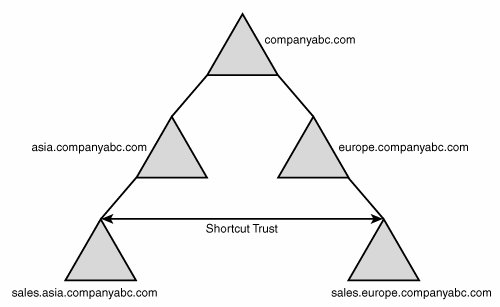Microsoft Windows Server 2003 Unleashed (R2 Edition)
| Before any domain design decisions can be made, it is important to have a good grasp of Active Directory's domain structure and functionality. Windows 2000 administrators will recognize many of the key components, but some fairly major changes have been made in Windows Server 2003 that require a reintroduction to the domain design process. In addition, real-world experience with AD domain design has changed some of the assumptions that were made previously. Domain Trusts
Windows Server 2003's Active Directory domains can be linked to each other through the use of a concept known as trusts. A trust is essentially a mechanism that allows resources in one domain to be accessible by authenticated users from another domain. As many administers will recall, domain trusts in NT 4.0 were one way, and not transitive. In other words, any resource sharing between multiple domains required numerous multiple-trust relationships. Trusts in Active Directory take a different approach than this "connect everything with trusts" approach. In Windows Server 2003's Active Directory, trusts are more powerful and simplistic at the same time. AD trusts take on many forms but typically fall into one of the four categories described in the following sections. Transitive Trusts
Transitive trusts are automatic two-way trusts that exist between domains in Active Directory. These trusts connect resources between domains in Active Directory and are different from Windows NT trusts in that the trusts flow through from one domain to the other. In other words, if Domain A trusts Domain B, and Domain B trusts Domain C, Domain A trusts Domain C. This flow greatly simplifies the trust relationships between Windows domains because it forgoes the need for multiple exponential trusts between each domain. Explicit Trusts
An explicit trust is one that is set up manually between domains to provide for a specific path for authentication sharing between domains. This type of trust relationship can be one way or two way, depending on the needs of the environment. In other words, all trusts in NT 4.0 could have been defined as explicit trusts because they all are manually created and do not allow permissions to flow in the same way as transitive trusts do. The use of explicit trusts in Active Directory allows designers to have more flexibility and to be able to establish trusts with external and down-level domains. All trusts between Active Directory domains and NT domains are explicit trusts. Shortcut Trusts
A shortcut trust is essentially an explicit trust that creates a shortcut between any two domains in a domain structure. For example, if a domain tree has multiple subdomains that are many layers deep, a shortcut trust can exist between two domains deep within the tree, similar to the shortcut trust shown in Figure 5.1. This relationship allows for increased connectivity between those two domains and decreases the number of hops required for authentication requests. Normally, those requests would have to travel up the transitive trust tree and back down again, thus increasing overhead. Figure 5.1. Shortcut trusts minimize hops between domains.
The example in Figure 5.1 shows how a shortcut trust could theoretically be used to reduce the overhead involved in sharing resources between the two sales subdomains in the companyabc.com tree. You can find more information on these trusts in the individual design model sections later in this chapter. Cross-Forest Transitive Trusts
Cross-forest transitive trusts are essentially two-way transitive trusts that exist between two disparate Active Directory forests. While explicit trusts between separate AD domains in separate forests were possible in Windows 2000, the cross-forest trusts in Windows Server 2003 allow for two-way transitive trusts to exist between two separate forests. More information can be found about this new variety of trust later in this chapter. |
